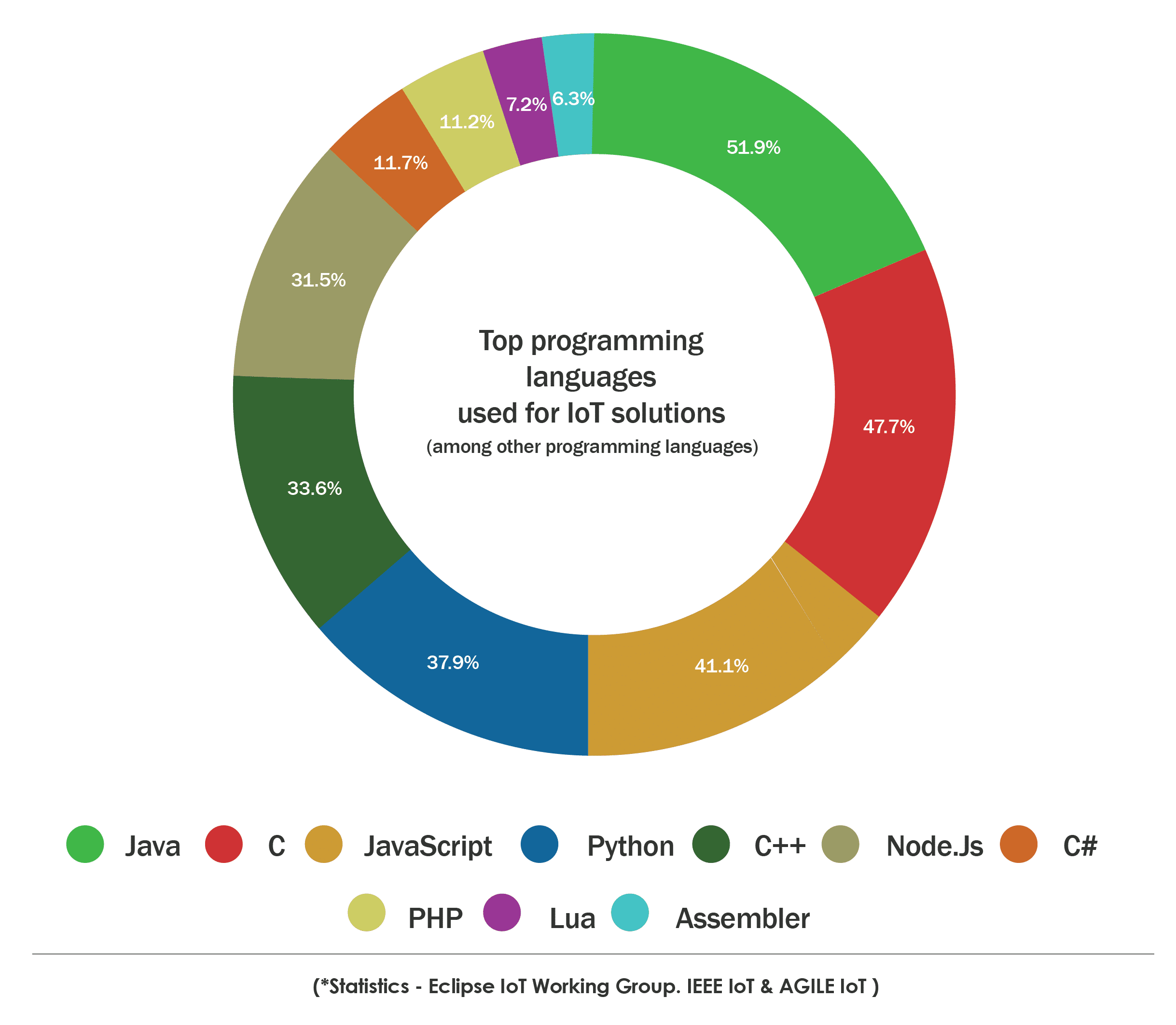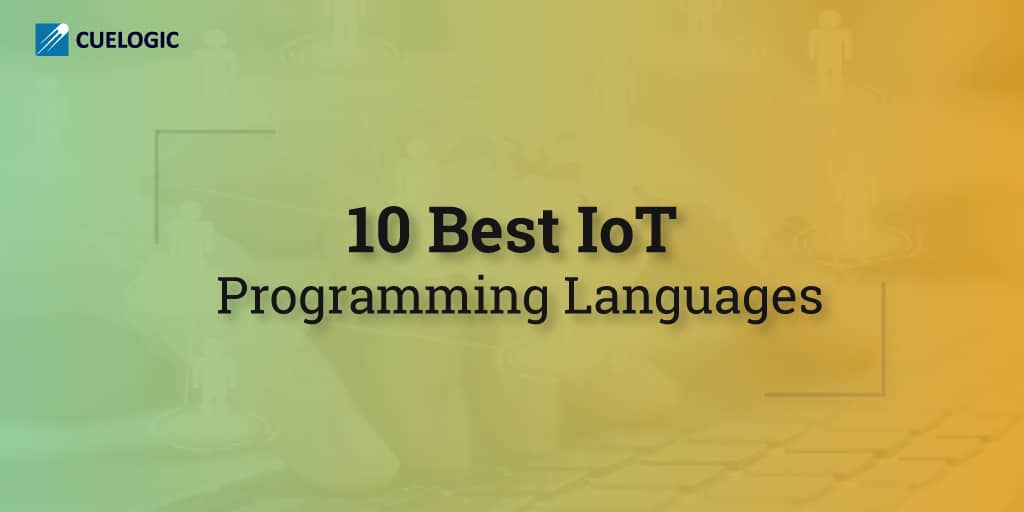There is no doubt that IoT is here to stay. According to a 2016 survey*, about 46% companies are delivering IoT solutions, while 29% plan to deliver an IoT solution in the next 18 months.
Among the top five IoT industries, home automation, energy management, industry automation and IoT platforms top the list.
Embedded software tops the current ‘technology focus for developers’ working on IoT App Development, followed by web development, big data and data analytics, enterprise software, DevOps solutions and services, cloud computing and mobile.
By the year 2017, a Gartner Inc. study estimates that 8.4 Billion things will be connected to the internet. To put this into perspective, the number of people on Earth in 2017 was 7.5 billion.

Selecting the right programming language for IoT-based product or service is a difficult decision to make.
In a world dominated by big data, cloud migration and mobile platforms, the right IoT language must aid inter-connectivity, security and interoperability (key IoT concerns according to the survey).
Easy embedding in code and the language’s long-term IoT future are deciding factors too.
Here is a comprehensive list of the most used programming languages in IoT :
1. Assembler – For compact projects
- Assembler is apt to make your IoT project compact, minimal and optimal.
- An assembler expert can work out many optimization tricks (thanks to minimal overhead) not available in any other programming mode. Downside: no safety net if code goes wrong.
- Assembler code writing is not for everybody too. Writing assembler code for a processor doesn’t mean you can write it for another. Not the best language to work on a prototype either.
- Assembler packages and assembles pure machine code efficiently to be executed by the processor.
2. B# – Small IoT project favorite
- In the world of large system languages, B# is a small, efficient embedded control language. Thanks to embedded virtual machine (EVM), B# can run on various platforms with only 24k memory, compared to overhead on other packages, this is less.
- B# keeps it minimal, mirroring C, but retaining only embedded project-required features. Instead it adds support to critical real-time control functions. If your project is small enough and not complex as Raspberry Pi, then B# is your language.
3. C – The base IoT language
- If you think embedded systems, C is a great choice for IoT. Completing complex tasks is simpler in C. The most widely used programming languages use C syntax.
- Also, finding developers with extensive experience in C is easy. C doesn’t provide ample support to GUI, one reason for its IoT unpopularity.
- As experts see it, C is the language for embedded systems programming. Its proximity to machine language makes it impressively fast.
4. C++ – Additional layers
- A more layered language with its objects, classes and abstractions. If you want to go beyond C and use programming code for IoT and embedded code, especially with Linux, C++ is the go-to program. As per 2016 statistics, Linux is the top IoT operating system.
5. Go Lang – Great with data
- Way ahead of C in embedded programming, Go is great for data gathering and data distribution to various sensors.
- Sorting an entire network of sensors and making use of related IoT programming related devices, is a Go Lang advantage. Available on varied platforms and processors, Go is loaded with several data gathering and distribution facilitating types.
- Go is all for concurrent input, output and processing on several different channels. Right usage of these elements can help one control an entire set of sensors. At the same time (as different channels are not aware of each other), a programmer’s glitch may cause system to behave unpredictably.

6. JavaScript – The all-around IoT performer
- A front end web application that will work wonders for IoT, especially when you go with Apache server on Raspberry Pi. It involves collecting data from a network of sensors.
- JavaScript fits the mold of event-driven architecture and is resource-efficient when it comes to sensors, be it with CPU usage or battery life.
- More JavaScript plus pointers – easy to learn, common language across the Internet, a strong developer community, ample video resources available (be it youtube.com, tutorials, websites) to understand the language.
7. Java – Return on investment
- Unlike C and C++, there are hardly any hardware-based dependencies to go with Java. It is a portable, object-oriented language. With hardly any hardware dependencies built into the compiler, Java makes use of hardware support libraries (called from generic code).
- If you consider return on investment, Java is a good bet. A language that developers can easily learn and practice. IoT app makers must be more concerned if their selected platform supports Java and whether hardware support libraries in use contain required control functions.
8. Parasail – Evolved language
- Need parallel processing for your IoT application? Go for parasail. An evolved language, compiled and object-oriented, it can be programmed with C, Java or Python syntax.
9. Python – For database-based apps
- Python is a good choice for an IoT app that requires readability and compact code. Its flexibility allows distribution of compact executable code. It can also be run through any run-time compiler for this purpose.
- Organized and neat, Python’s clean syntax is great for database arrangement. If any app requires data to be arranged in a database format and uses tables for data control, Python is your thing. It is also miles ahead of C, C++ in embedded platforms.
10. Rust – For concurrent programming
- Developed by Mozilla, shares many Go lang qualities. It fixes one big Go lang drawback, the latter’s automatic information sharing ability among various channels. Rust fixed this problem by building support functions.
- Rust is now popular among IoT programming languages, especially for concurrent programming. Possible glitch – the processor should support concurrent processing, to use Rust.
Summary
At the time of writing, these select languages are among the most used and popular to be used in IoT-based applications. Among them – C, JavaScript, Java and Python are the most popular IoT languages.
But most importantly, the language should be concurrent with the enterprise and technical goals associated with its use.
We shall be subsequently writing more on other aspects of IoT in our blogs, so check our blogs out for more.
Which language do you prefer? Let us know in the comments.
(*Statistics – Eclipse IoT Working Group. IEEE IoT & AGILE IoT )
